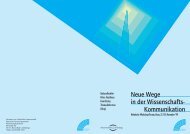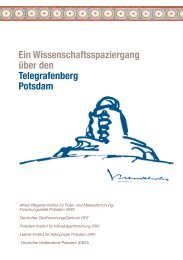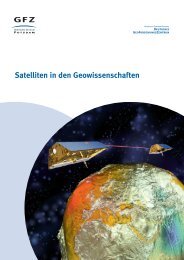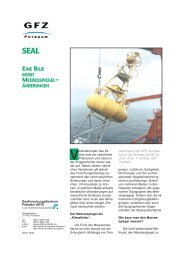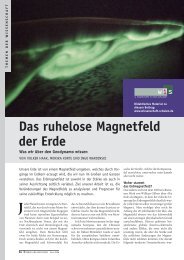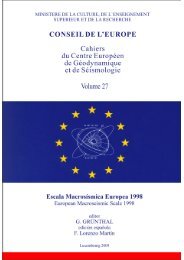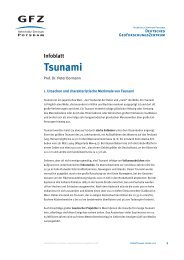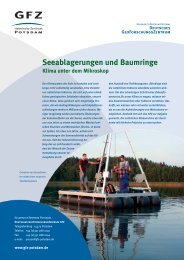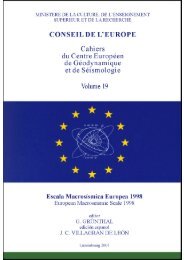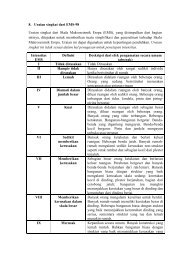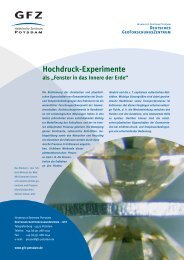Galactic Cosmic Rays - GFZ
Galactic Cosmic Rays - GFZ
Galactic Cosmic Rays - GFZ
You also want an ePaper? Increase the reach of your titles
YUMPU automatically turns print PDFs into web optimized ePapers that Google loves.
Nacreous clouds over Oslo Source:Aerosol-cloud-climateinteractions and cosmic raysJón Egill Kristjánsson, Univ. OsloCamilla W. Stjern, Univ. Oslo
Forster et al. (2007: IPCC AR4)Radiative Forcing 1750 - 2005Aerosols:LargeUncertaintyNatural:+0.10 W m -2Anthropogenic: +1.6 W m -2
Correlations between<strong>Galactic</strong> <strong>Cosmic</strong> <strong>Rays</strong> and LowClouds (IR only)Marsh and Svensmark (2000: Phys.Rev.Lett.)
Enhancement of the solarsignal?Via cosmic rays?
Suggested Mechanisms• Absorption of UV in the stratosphere Influenceon planetary waves in the troposphere (J. Haigh)• Variations in the length of the solar cycle (E. Friis-Christensen)• <strong>Galactic</strong> <strong>Cosmic</strong> <strong>Rays</strong> Aerosol Nucleation Low Clouds (H. Svensmark)• <strong>Galactic</strong> <strong>Cosmic</strong> <strong>Rays</strong> Electric charge onclouds Cloud Amount (G. Harrison, B.Tinsley)• Absorption of solar irradiance by the ocean SeaSurface Temperatures Low Clouds (J.E.Kristjánsson)
Ion-aerosol clear-air mechanismCarslaw et al. (2002: Science)
GCR Ion Production vs. HeightSolar Max.Solar Min.• Max ionizationat 13 km• Max ionizationat solarminimum• Max ionizationat high latitudesNeher (1971: JGR)
Recent Observational StudiesEmphasis on Forbush Decrease(FD) Events
Forbush Decrease Events
MODIS 2003 06 26 19:40Rosenfeld et al. (2006: ACP)38N136W134W34N
Kristjánsson et al. (2008: ACP)Regions of StudyAreas of large cloud susceptibility selected
Kristjánsson et al. 2008 (Atm.Chem.Phys.):Focus on low clouds in the region 0° – 40°S; Averages of 22 ‘Forbush Decrease’eventsKristjánsson et al. (2008: Atmos. Chem. Phys.)
Signals of cosmic rays in particle size, cloud cover and cloud water
Revisiting the 5 FD events• Signal dominated bythe 2 nd strongestevent (19 Jan 2005),which in fact was amajor solar protoneventLaken et al. (2009: Geophys. Res. Lett.)
Signals in SW or LW Radiation atTOA?CERES data
SWCF and LWCF
Net Cloud Forcing• Following an FD eventthere is a reduction inthe negative Net CloudForcing• This is consistent with areduction in cloudamount• Statistically significant?• Other causes?
Case SelectionCalogovic et al. (2010: Geophys. Res. Lett.)• Six Forbush DecreaseEvents were selected• 3-Hourly Cloud CoverData (ISCCP D1)• Spatial resolution:5°x5°• More than 100 000 gridcells were analyzed• All solar proton eventsexcluded from data
Correlations between cosmic raysand cloudsCalogovic et al. (2010: Geophys. Res. Lett.)• Neither high, middlenor low clouds showany correlation withcosmic rays• Correlations behavevery similarly in testdata that have nearconstantcosmic rayflux
GCR vs. Low Clouds5-6 day lag used- The correlations do not show anysystematic spatial pattern- Normal distribution centered around0Calogovic et al. (2010: Geophys. Res. Lett.)
Aerosol NucleationMeasurementsKulmala et al. (2010: Atmos.Chem.Phys.)
Kulmala et al. (2010: ACP)Aerosol Nucleation at HyytiäläMonthly dataAnnual data25 – 100nm100 – 1000nm
Will the CERN experiments bring new insight?
Model studies
Yu et al. (2008: ACP)Aerosol Nucleation due to <strong>Cosmic</strong>• Maximum influenceon aerosol formationin the upper tropicaltroposphere (10 – 15km) height• Subsequent influenceon clouds not known<strong>Rays</strong>
• Calculations in a climate model with advanced aerosol physics’on-line’• Explicitly calculate the effect of ionization on aerosolnucleation• Focus on changes over a solar cycle
Pierce & Adams (2009: Geophys.Res.Lett.)Cloud condensation nuclei at solarmin/ solar-max• Standard assumptionon the influence ofionization• Extreme assumptionon the influence ofionization
Pierce & Adams (2009: Geophys.Res.Lett.)In both simulations the CCN signal from changes incosmic rays over a solar cycle is very weakThe consequence is a negligible radiative forcing(~0.01 W m -2 )
Rising Temperatures – No Trend in <strong>Cosmic</strong><strong>Rays</strong>SunspotsSolar Magnetic Flux<strong>Galactic</strong> <strong>Cosmic</strong> <strong>Rays</strong>Solar IrradianceGlobal TemperatureLockwood and Fröhlich (2007: Proc. Roy. Soc.)
Summary• It is well established that charge can enhanceaerosol nucleation, and that nucleated aerosols mayeventually grow to CCN size• Does cosmic ray induced ionization influence clouds?• Recent studies of Forbush Decrease events givedifferent answers• No cosmic ray signal in aerosol nucleation events inEurope• Little support from model studies• Global temperature seemingly uninfluenced bycosmic rays
Foto: Michael GaussThank you!http://www.uio.no/~jegill
<strong>Cosmic</strong> rays last 45 yearsSource: http://cosmicrays.oulu.fi
How relevant are Svensmark’sfindings for global climate?
Ion-aerosol near-cloudmechanismCarslaw et al. (2002: Science)
Ionization distribution• Calculated ionproduction rate fromday -5 to day +15relative to an FDevent, as a function oflatitude, longitude andaltitudeCalogovic et al. (2010: Geophys. Res. Lett.)
Power spectrum Pacific Basin SST,SLPTourre et al. (2001: GRL)
GCR, TSI and Low CloudsKristjánsson et al. (2004: Adv. Sp. Res.)
Spatial distribution ofcorrelations
Foukal et al. (2004: Science)Blue curves:Sun spotsEstimated contribution from solaractivity to climate change last 400yearsRed curve:Estimatedradiative forcingRed curve:Estimatedtemperaturechange
SST vs. Low Cloud CoverKristjánsson et al. (2002: GRL)
Pre-historic climate variations andcosmic rays• During the Laschampevent 36,000 –41,500 years ago theindicators for cosmicrays ( 10 Be + 36 Cl)were not correlatedwith indications forclimate (δ 18 O,CH 4 )Muscheler et al. (2001: AGU Monograph)
<strong>Cosmic</strong> <strong>Rays</strong> vs. ISCCP Low CloudAmount 1983-2005<strong>Cosmic</strong><strong>Rays</strong>Low Cloud Amount
Is the signal really coming from lowclouds?
Is the signal really coming from lowclouds?




